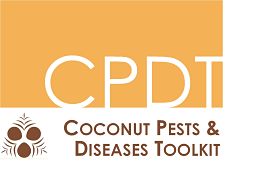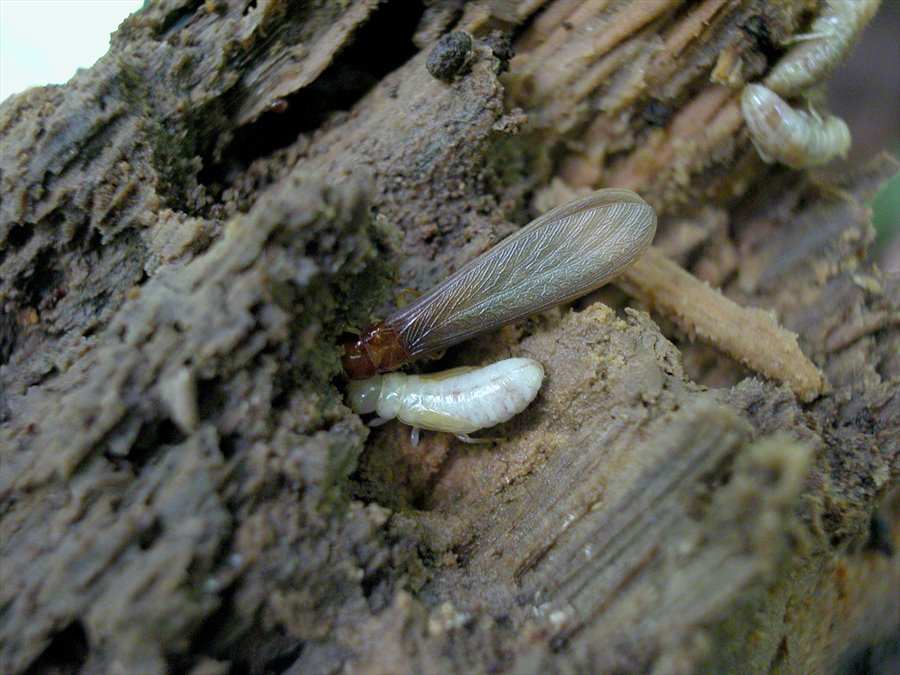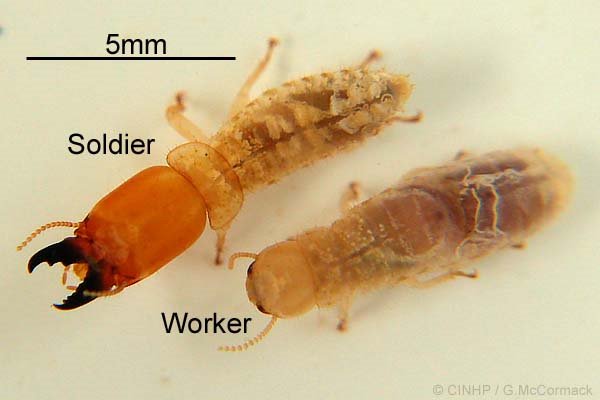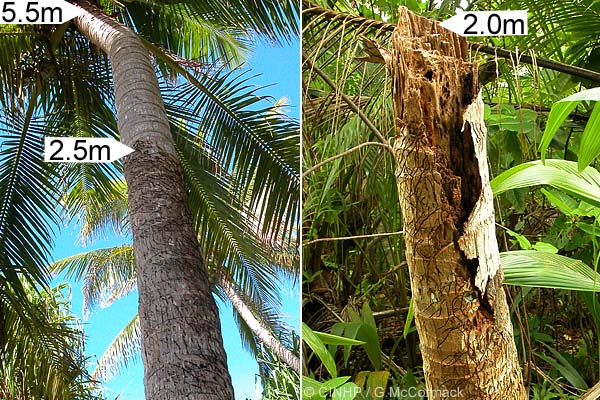Coconut termite
The coconut termite is a serious pest in Pacific communities. This is a HIGH risk pest.
Common nameCoconut termite |
Scientific nameNeotermes rainbowi (Termitoidae: Kalotermitidae) |
on this page: Life-cycle and identification : Symptoms : Impacts : Distribution : Prevention : Controlling coconut termite : Information sources and further reading
Life-cycle and identification
Termites are social insects - they live in colonies of many individuals. These individuals share the work required for the colony to reproduce and survive, and the colony contains overlapping generations.
The work in the colony is performed by different types of individuals – called castes. These different types of insects all have different 'jobs' in the termite community.
In a termite colony the castes are typically the king and queen for reproduction, soldiers to defend the colony, and workers to forage for food and tend the young.
Reports of Neotermes rainbowi are regularly confused with other species of termite. The need for a termite specialist to correctly identify the insect may delay action to remove infestations.
|
Coconut termites attack the wood in the trunks of living coconut palms. New colonies are established in suitable wood by a pair of winged adults - a male and a female (see top image on right). These are called the king and queen, or the founding or royal pair. After flying from the colony in which they were produced, winged termite adults land on the ground and lose their wings. They find a partner and make their way into suitable wood, typically through wounds or cracks in the tree, or they may chew a small tunnel. Of all the termites in the nest, only the king and queen termites reproduce. The king and queen are the parents of all the soldier and worker termites. If a king or queen dies or is injured, a young termite within the colony can take their place. Colonies are thought to live for 20 years or more. Eggs are laid by the female queen. The nymphs that hatch from the eggs grow to become either soldiers or workers that stay within the colony, or winged adults that leave to start new colonies. The colony will grow if the workers and soldiers provide food, care and protection for the king and queen termite and their offspring. Worker termites are the most abundant type of termite in the colony. They do not have many distinctive features, and workers of different species look very similar (see middle image on the right). Soldier termites differ from workers. Soldiers have a large brown head and distinct dark mandibles (mouthparts) and are 8-10 mm in length (see Figure 2). Soldier termites are the most often used caste for identification of termite species. Alates (termite adults with wings) are also useful for identification. Workers and nymphs are not very useful for identification. Soldiers or alates should be collected when possible if identification is required. SymptomsAt first a few holes and small grooves filled with chips of bark appear on the surface of the trunk near the base. Then a characteristic net-like pattern of grooves and channels occurs through the entire depth of the bark (see lower image on the right). This attack may start near the base of the trunk (just above the uppermost roots) or a few metres above the ground. |
A winged adult and worker of the coconut termite. (© Gerald McCormak, Cook Island Biodiversity & Natural Heritage)
Soldier coconut termite with distinct mandible compared to a worker termite (© Gerald McCormak, Cook Island Biodiversity & Natural Heritage)
Characteristic net-like grooves on the trunk up to a few metres from soil level (© Gerald McCormak, Cook Island Biodiversity & Natural Heritage) |
The grooves are covered in material made from a mixture of chewed wood/ bark and faecal matter (termite droppings). This attack then extends upwards over time as the termite colony grows.
As a colony grows, cavities are eaten out of the trunk. This may extend out to the surface of the bark. These cavities are filled with a soft moist mixture of faeces and wood debris. This damage leads to the trunk snapping.
In some locations coconut termite may be able to move from an infested tree to neighbouring trees through the roots and soil. This termite may also attack other trees such as Pandanus.
Hollowed out coconut stumps are also an indication of termite infestation or presence of termites in the area.
Because coconut termite hollows out the middle of the palm trunk, the trunk can snap even in light winds.
Impacts
The main impact of coconut termite is through their structural damage to the palm, which leads to windthrow/windsnap. These termites may not affect nut yield of mature trees that remain intact, but yield in young palms may be reduced or they can be destroyed before nut bearing has occurred.
The holes, grooves and hollowing made by the termites can allow entry into the palm of other pests and diseases.
Distribution
Please check with your local biosecurity / quarantine or SPC for up-to-date distribution information.
Coconut termite is present in Oceania, in the Central Pacific and many atoll countries. It is reported to be present in the Cook Islands, Tuvalu and Fiji (Rotuma group). The Rotuma observation has has been questioned due to unusual symptoms. Records in Tokelau are also yet to be confirmed.
Prevention
Most importantly, the International Guidelines for transfer of coconut germplasm should be strictly followed to prevent pests and diseases being moved to new locations.
Regulation of host tree transportation is highly important. All transport should be checked through quarantine.
Planting within dense bush or in close proximity to Pandanus or other palms may increase the risk of infestation by termites tunnelling through roots and soil.
Although the distance flown by the colonising king and queen termite is no longer than a few kilometres, larger scale spread has been recorded through transportation (aeroplane and water transport) . Coconut termite can easily form colonies from a small starter group of immature insects moved to a new location.
The pest can also be spread through transportation of other host trees such as Pandanus.
For general information on preventing pests and diseases of coconut, see the Prevention section.
Controlling coconut termite
We strongly recommend an integrated pest management (IPM) approach to the control of all insects, where possible. This is a combination of methods (pesticides, physical controls such as site hygiene, and biological controls) to minimise the use of pesticides and minimise the cost of control.
Integrated Pest Management (IPM)
The goal of IPM is to keep pest populations to a level below which they cause economic harm. IPM involves using multiple control options together for the economic control of pests (i.e. cultural, natural and chemical).
In an agricultural context the Food and Agriculture Organization defines IPM as "the careful consideration of all available pest control techniques and subsequent integration of appropriate measures that discourage the development of pest populations and keep pesticides and other interventions to levels that are economically justified and reduce or minimize risks to human health and the environment. IPM emphasizes the growth of a healthy crop with the least possible disruption to agro-ecosystems and encourages natural pest control mechanisms".
Cultural
Characteristic net-like grooves are a clear indication of infestation and these should be destroyed immediately by removing and burning to reduce the spread to healthy palms. This method is physically demanding but can reduce populations.
Unfortunately, no coconut varieties have shown resistance to termites.
Natural
Coconut termites are eaten by birds, lizards, snakes, frogs, ants, mites, fungi, and nematodes. However, they are not all considered to be effective in controlling coconut termites. For example, ants can cause more of a problem than the termites.
Tuvalu has used injections of entomopathogenic (insect-killing) Metarhizium anisopliae fungus strains and a Heterorhabditis species of nematode (parasitic round-worm) against termites. These could be promising biocontrol agents.
Chemical
The use of chemicals is not considered a cost-effective or environmentally sustainable control agent for coconut termites. Insecticides can contaminate the water table and cause harm to human and animal health. Many that were used in the past are now banned.
Information sources and further reading
Cook Islands Biodiversity Database. Coconut Termite (Neotermes rainbowi). [ONLINE]
PestNet. 2017. Coconut termite. [ONLINE].
Machar, Benjamin, Deng El Tahir. 2016. Coconut seedling (Cocos nucifera) losses due to termite pest species and possible control measures. African Journal of Agriculture, 3, 3, 148-153.
Waterhouse. 1993. Biological control - Pacific prospects: supplement 2; Neotermes rainbowi. [ONLINE]
Western and National Plant Detectors News. 2013/2014. Pacific Pest Detector News. [ONLINE]
content reviewed by Shaun Bennett, Plant Health and Environment Laboratory, Ministry of Primary Industries, New Zealand, November 2018



